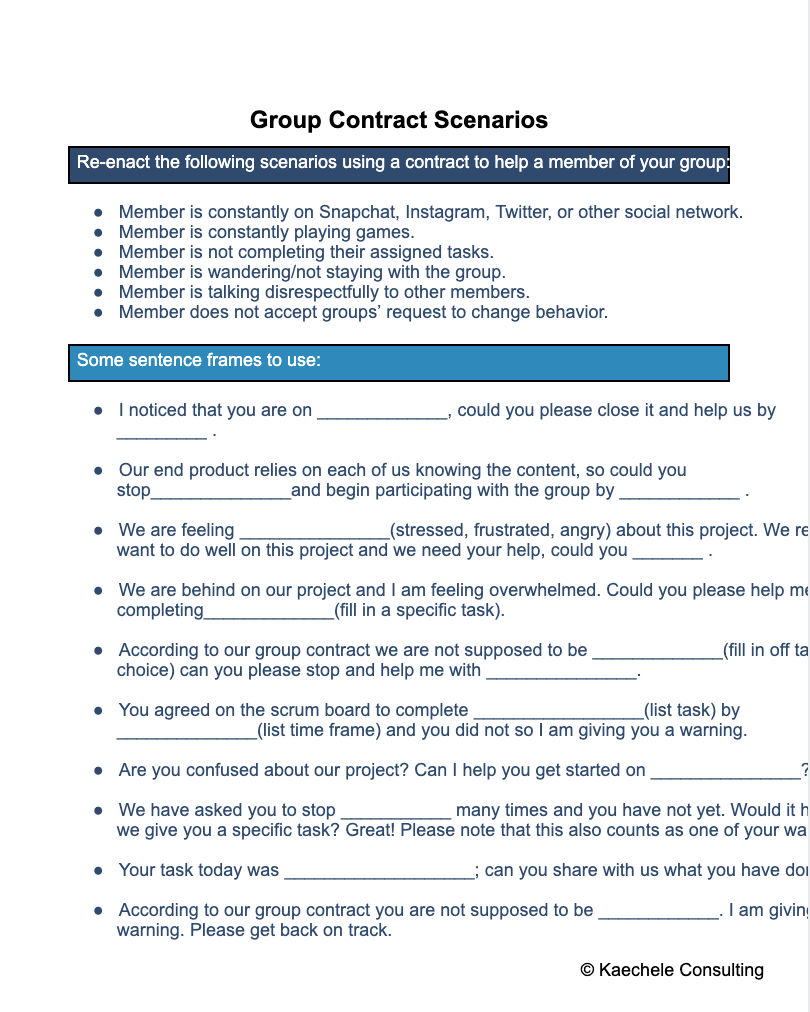
One reason why a large subset of students struggle in school is that they lack organization. These are the kids who do their homework but never turn it in. It is probably “lost” somewhere in their backpack. At the end of the year when these students clean out their lockers, they are full of papers everywhere that may or may not have been graded. Sometimes we forget to have a growth mindset about these kids.
Lack of organization is not a character trait that is permanent. It is a skillset that all students can learn.
In PBL, we use tools from the business world such as scrum boards (also known as kanban boards). They can take on many forms depending on the age of the students and the technology available. The basic format is four columns: To Do, Doing, Need Support, and Done.

Initially, tasks from the Need to Know list are added to the To Do column, assigned to group members, and due dates are negotiated. As students engage in a task, they move it over to the appropriate column to track progress. Scrum boards can be created online in a business tool such as Trello (student template) or on a shared spreadsheet (see below). That way everyone, including the teacher can monitor progress.

For younger students or as a no-tech option, students can use sticky notes on poster paper. Another option is to create a scrum board chart on a bulletin board. No matter which format you choose, scrum boards are a great tool to teach students how to manage both their work and themselves. They give structure to goal setting and help students manage stress by creating a realistic timeline, instead of cramming it all in at the last minute.

Student roles, group contracts, and scrum boards help students learn how to interact with each other in productive ways and invoke teamwork for successful completion of their goals. Let’s consider how these tools work together. We combine group contracts with scrum boards to make student warnings based off of work completion rather than personality conflicts. Instead of “You are annoying. I can’t stand you so I am giving you a warning,” I teach students that warnings are based off from the scrum board.
“We’re friends, but you committed to having this task done by today and it isn’t completed. I am sorry, but I am giving you a verbal warning. And just so you know, it is really stressing me out because I care about this project and want to do well.”
The last sentence, where students express the stress and emotion that they are feeling (Self-Awareness) is key. Many times the other student may not care as much about the work personally, but will be motivated by social pressure not to let their teammates down.
Many students are uncomfortable giving a classmate a warning. One strategy I use is sentence stems and roleplaying. Students rehearse how they would handle situations by acting out scenes based on persistent issues in class. This is a safe way for them to practice and feel comfortable using effective communication to share feelings and solve group conflicts.

I like to use triads where one student takes the role of the challenging behavior and one student is enforcing the contract while the third student observes and gives feedback afterward. Choose three common situations from your class and rotate roles so everyone has a chance to practice using the sentence stems with contracts. Another variation is to have another teacher or two visit your class and the adults role play for students.
This does not have to be focused on behavior. Some colleagues of mine roleplayed how to have a five minute academic discussion so that students could see how to build off from other people’s comments and opinions.
Modeling is just as important for SEL skills as it is for content.
Try launching you class with a daily scrum meetings to teach students to track and assess their progress on their self-selected timeline. The most compelling form of evaluation is self-assessment. When a student honestly and accurately analyzes themselves, it is powerful! They can check in on their group contracts and determine whether or not they are being an effective team member. Scrum boards and contracts enable student growth in goal setting and organization leading to success that builds both their abilities and their confidence.
Questions? Interested in SEL and PBL Consulting? Connect with me at michaelkaechele.com or @mikekaechele onTwitter.

